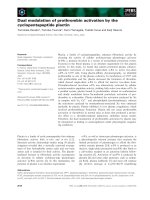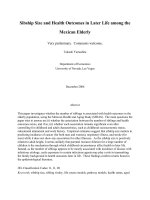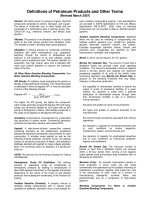Cash and ReceivablesInsert Book Cover Picture7Copyright © 2007 by The McGraw-Hill Companies, ppt
Bạn đang xem bản rút gọn của tài liệu. Xem và tải ngay bản đầy đủ của tài liệu tại đây (662.22 KB, 30 trang )
1
Copyright © 2007 by The McGraw-Hill Companies, Inc. All rights reserved.
Cash and
Receivables
7
Insert Book Cover
Picture
7-2
Cash
Amounts on
deposit with
financial
institutions
Coins and
currency
Petty cash
Cashier’s checks
Certified checks
Money orders
7-3
Cash Equivalents
Items very near cash but
not in negotiable form
Money market
funds
Treasury bills
Commercial
paper
2
7-4
Learning Objectives
Define what is meant by internal control and
describe some key elements of an internal
control system for cash receipts and
disbursements.
7-5
Internal Control of Cash
Encourages adherence
to company policies
and procedures
Promotes operational
efficiency
Minimizes errors
and theft
Enhances the reliability
and accuracy of
accounting data
7-6
Control of Cash Receipts
Separate responsibility for
§ handling cash,
§ recording cash transactions, and
§ reconciling cash balances.
Agreed cash amounts deposited with cash
amounts received.
Close supervision of cash-handling and cash-
recording activities.
3
7-7
Control of Cash Disbursements
Separate responsibilities for
§ cash disbursement documents,
§ check writing,
§ check signing,
§ check mailing, and
§ record keeping.
All disbursements, except petty cash, made by
check.
7-8
Learning Objectives
Explain the possible restrictions on cash and
their implications for classification in the
balance sheet.
7-9
Restricted Cash and
Compensating Balances
Restricted Cash
Management’s intent to use a certain amount
of cash for a specific purpose – future plant
expansion, future payment of debt.
Compensating Balance
Minimum balance that must be maintained
in a company’s account as support for
funds borrowed from the bank.
4
7-10
Learning Objectives
Distinguish between the gross and net
methods of accounting for cash discounts
7-11
Credit sales require:
§ Maintaining a separate
account receivable for each
customer.
§ Accounting for bad debts
that result from credit
sales.
Amounts due from
customers for credit sales.
Accounts Receivable
7-12
Cash Discounts
Increase sales.
Encourage early
payment.
Increase likelihood of
collections.
Cash discounts . . .
5
7-13
2/10,n/30
Number of
Days
Discount is
Available
Otherwise,
Net (or All)
is Due
Credit
Period
Discount
Percent
Cash Discounts
7-14
Cash Discounts
Sales are
recorded at the
invoice
amounts.
Sales discounts
are recorded if
payment is
received within
the discount
period.
Gross
Method
7-15
Cash Discounts
Sales are recorded at the
invoice amount less the
discount.
Sales discounts forfeited
Sales discounts forfeited
are recorded if payment
is received after the
discount period.
Net
Method
6
7-16
Cash Discounts
On May 10, Eddy, Inc. sold $5,000 of
merchandise to a customer subject to a cash
discount of 1/10, n/30.
Prepare the journal entry to record the sale if
Eddy uses:
(a) the gross method.
(b) the net method.
7-17
Cash Discounts
GENERAL JOURNAL
Page 56
Date Description
Post.
Ref. Debit Credit
GROSS METHOD
May 10 Accounts Receivable 5,000
Sales Revenue 5,000
NET METHOD
May 10 Accounts Receivable 4,950
Sales Revenue 4,950
7-18
Cash Discounts
Assume that on May 19, Eddy, Inc. received a
check in full payment of the sale made on
May 10.
Prepare the journal entry to record the cash
receipt if Eddy uses:
(a) the gross method.
(b) the net method.
7
7-19
Cash Discounts
GENERAL JOURNAL
Page 56
Date Description
Post.
Ref. Debit Credit
GROSS METHOD
May 19 Cash 4,950
Sales Discount 50
Accounts Receivable 5,000
NET METHOD
May 19 Cash 4,950
Accounts Receivable 4,950
7-20
Cash Discounts
Instead of the payment on May 19, now assume
that Eddy, Inc. received a check on May 31, in
full payment of the sale made on May 10.
Prepare the journal entry to record the cash
receipt if Eddy uses:
(a) the gross method.
(b) the net method.
7-21
Cash Discounts
GENERAL JOURNAL
Page 56
Date Description
Post.
Ref. Debit Credit
GROSS METHOD
May 31 Cash 5,000
Accounts Receivable 5,000
NET METHOD
May 31 Cash 5,000
Interest Revenue 50
Accounts Receivable 4,950
8
7-22
Learning Objectives
Describe the accounting treatment for
merchandise returns.
7-23
Sales Returns
Merchandise
returned by a
customer to a
supplier.
Sales Allowances
A reduction in
the cost of
defective
merchandise.
Sales Returns and Allowances
7-24
Sales Returns and Allowances
On June 1, a customer of LarCo returns
$750 of merchandise. The merchandise
had been purchased on account and the
customer had not yet paid. LarCo uses
the periodic method to account for
inventory.
Record the journal entry for the return of
merchandise.
9
7-25
Sales Returns and Allowances
GENERAL JOURNAL
Page 56
Date Description
Post.
Ref. Debit Credit
Jun 1
Sales Returns and Allowances 750
Accounts Receivable 750
Sales Returns and Allowances is a contra
account that reduces Sales Revenue in the
current accounting period.
7-26
Learning Objectives
Describe the accounting treatment of
anticipated uncollectible accounts receivable.
7-27
Uncollectible Accounts Receivable
Bad debts result from credit customers who
are unable to pay the amount they owe,
regardless of continuing collection efforts.
PAST DUE
10
7-28
Uncollectible Accounts Receivable
In conformity with the matching principle,
bad debt expense should be recorded in
the same accounting period in which the
sales related to the uncollectible account
were recorded.
7-29
Uncollectible Accounts Receivable
Most businesses record an estimate of the
bad debt expense by an adjusting entry
at the end of the accounting period.
GENERAL JOURNAL
Page 78
Date Description
Post.
Ref. Debit Credit
Dec. 31 Bad Debt Expense ####
Allowance for Uncollectible ####
Accounts
7-30
Uncollectible Accounts Receivable
GENERAL JOURNAL
Page 78
Date Description
Post.
Ref. Debit Credit
Dec. 31 Bad Debt Expense ####
Allowance for Uncollectible ####
Accounts
Normally classified as
a selling expense and
closed at year-end.
Contra asset account to
Accounts Receivable.
11
7-31
Allowance for Uncollectible Accounts
Net realizable value is the amount of the
accounts receivable that the business
expects to collect.
Accounts Receivable
Less: Allowance for Uncollectible Accounts
Net Realizable Value
7-32
Learning Objectives
Describe the two approaches
to estimating bad debts.
7-33
p
Income Statement Approach
p
Balance Sheet Approach
Composite Rate
Aging of Receivables
PAST DUE
Estimating Bad Debts
12
7-34
Income Statement Approach
p
Focuses on past credit sales to make
estimate of bad debt expense.
p
Emphasizes the matching principle by
estimating the bad debt expense associated
with the current period’s credit sales.
7-35
Bad debts expense is
computed as follows:
Current Period Credit Sales
× Bad Debt %
= Estimated Bad Debts Expense
Income Statement Approach
7-36
In 2006, MusicLand has
credit sales of $400,000 and
estimates that 0.6% of credit
sales are uncollectible.
What is Bad Debts Expense
for 2006?
Income Statement Approach
13
7-37
GENERAL JOURNAL
Page 95
Date Description
Post
Ref. Debit Credit
Dec. 31 Bad Debts Expense 2,400
Allowance for
Uncollectible Accounts 2,400
400,000$
× 0.60%
= 2,400$
MusicLand computes
estimated Bad Debts
Expense of $2,400.
Income Statement Approach
7-38
Balance Sheet Approach
p
Focuses on the collectibility of accounts
receivable to make the estimate of uncollectible
accounts.
p
Involves the direct computation of the desired
balance in the allowance for uncollectible
accounts.
7-39
ΠCompute the desired balance in the Allowance for
Uncollectible Accounts.
• Bad Debts Expense is computed as:
Year-end Accounts Receivable
×
Bad Debt %
Balance Sheet Approach
Composite Rate
14
7-40
What is MusicLand’s Bad Debts
On Dec. 31, 2006, MusicLand
has $50,000 in Accounts
Receivable and a $200 credit
balance in Allowance for
Uncollectible Accounts.
Past experience suggests that
5% of receivables are
uncollectible.
What is MusicLand’s Bad Debts
Expense for 2006?
Balance Sheet Approach
Composite Rate
7-41
GENERAL JOURNAL
Page 95
Date Description
Post
Ref. Debit Credit
Dec. 31 Bad Debts Expense 2,300
Allowance for
Uncollectible Accounts 2,300
50,000$
× 5.00%
= 2,500$
Desired balance in Allowance
for Uncollectible Accounts
Balance Sheet Approach
Composite Rate
7-42
Now, let’s
look at the
accounts
receivable
aging
approach!
15
7-43
ΠYear-end Accounts Receivable is
broken down into age classifications.
•
Each age grouping has a different
likelihood of being uncollectible.
Ž
Compute desired uncollectible amount.
Balance Sheet Approach
Aging of Receivables
•
Compare desired uncollectible amount
with the existing balance in the
allowance account.
7-44
EastCo, Inc.
Schedule of Accounts Receivable by Age
December 31, 2006
Days Past Due
Accounts
Receivable
Balance
Estimated
Bad Debts
Percent
Estimated
Uncollectible
Amount
Current 45,000$ 1% 450$
1 - 30 15,000 3% 450
31 - 60 5,000 5% 250
Over 60 2,000 10% 200
67,000$ 1,350$
Œ • Ž
At December 31, 2006, the receivables for
EastCo, Inc. were categorized as follows:
Balance Sheet Approach
Aging of Receivables
7-45
GENERAL JOURNAL
Page 95
Date Description
Post
Ref. Debit Credit
EastCo’s unadjusted balance
in the allowance account is
$500.
Per the previous computation,
the desired balance is $1,350.
500
1,350
Allowance for
Uncollectible
Accounts
Prepare the entry to record bad debts
expense at Dec. 31, 2006.
•
Balance Sheet Approach
Aging of Receivables
16
7-46
500
850
1,350
Allowance for
Uncollectible
Accounts
GENERAL JOURNAL
Page 95
Date Description
Post
Ref. Debit Credit
Dec. 31 Bad Debts Expense 850
Allowance for
Uncollectible Accounts 850
Balance Sheet Approach
Aging of Receivables
EastCo’s unadjusted balance
in the allowance account is
$500.
Per the previous computation,
the desired balance is $1,350.
•
7-47
Balance Sheet
Approach
Emphasis on
Realizable Value
Accts.
Rec.
All. for
Uncoll.
Accts.
Income
Statement
Focus
Balance Sheet
Focus
Income
Statement
Approach
Emphasis on
Matching
Sales
Bad
Debts
Exp.
Methods to Estimate Bad Debts
7-48
Uncollectible Accounts
As accounts become uncollectible, the
following entry is made:
GENERAL JOURNAL
Page 69
Date Description
Post.
Ref. Debit Credit
Allowance for Uncollectible Accounts ####
Accounts Receivable ####
So what happens if someone pays after a write-off
of the accounts receivable?
17
7-49
GENERAL JOURNAL
Page 69
Date Description
Post.
Ref. Debit Credit
Accounts Receivable ####
Allowance for Uncollectible Accounts ####
Cash ####
Accounts Receivable ####
Collection of Previously
Written-Off Accounts
When a customer makes a payment after an
account has been written off, two journal
entries are required.
Œ
•
7-50
GENERAL JOURNAL
Page 18
Description
Post
Ref. Debit Credit
Bad Debts Expense #####
Accounts Receivable #####
Date
If uncollectible accounts are immaterial, bad
debts are simply recorded as they occur
(without the use of an allowance account).
Direct Write-off Method
7-51
Learning Objectives
Describe the accounting treatment of short-
term notes receivable.
18
7-52
PROMISSORY NOTE
Face Value Date
after date I I promise to pay to the order of
Westward, Inc.
Dollars
plus interest at the annual rate of .
$25,000 Nov. 1, 2006
One year
12%
Twenty-five thousand and no/100
Janet Lee ,
Winn,Co.
Maker
Payee
Principal
Interest Rate
Date of
Note
Term
Notes Receivable
7-53
Face
amount
of the
note
×
Annual
interest
rate
×
Fraction of
the annual
period
= Interest
Even for
maturities less
than 1 year,
the rate is
annualized.
Interest Computation
7-54
Interest-Bearing Notes
On November 1, 2006, Westward, Inc. loans
$25,000 to Winn, Co. The note bears
interest at 12% and is due on November 1,
2007.
Prepare the journal entry on November 1,
2006, December 31, 2006, (year-end) and
November 1, 2007 for Westward.
19
7-55
Interest-Bearing Notes
GENERAL JOURNAL
Page 56
Date Description
Post.
Ref. Debit Credit
2006
Nov 1 Notes Receivable 25,000
Cash 25,000
Dec 31 Interest Receivable 500
Interest Revenue 500
$25,000 × 12% × (2 ÷ 12) = $500
7-56
Interest-Bearing Notes
GENERAL JOURNAL
Page 56
Date Description
Post.
Ref. Debit Credit
2007
Nov 1 Cash 28,000
Note Receivable 25,000
Interest Receivable 500
Interest Revenue 2,500
$25,000 × 12% = $3,000 - $500 = $2,500
7-57
Noninterest-Bearing Notes
§ Actually do bear interest.
§ Interest is deducted
(discounted) from the face
value of the note.
§ Cash proceeds equal face
value of note less discount.
20
7-58
Noninterest-Bearing Notes
On January 1, 2006, Westward, Inc. accepted
a $25,000 noninterest-bearing note from
Winn, Co as payment for a sale. The note is
discounted at 12% and is due on December
31, 2006.
Prepare the journal entries on January 1,
2006, and December 31, 2006 for Westward.
7-59
Noninterest-Bearing Notes
GENERAL JOURNAL
Page 56
Date Description
Post.
Ref. Debit Credit
2006
Jan 1 Notes Receivable 25,000
Discount on Notes Receivable 3,000
Sales Revenue 22,000
$25,000 × 12% = $3,000
Dec 31 Cash 25,000
Discount on Notes Receivable 3,000
Interest Revenue 3,000
Notes Receivable 25,000
7-60
Learning Objectives
Differentiate between the use of receivables
in financing arrangements accounted for
as a secured borrowing and those
accounted for as a sale.
21
7-61
Financing With Receivables
Secured borrowing
or
Sale of receivables
Method depends on the
surrender of control over
the receivables transferred.
7-62
Secured Borrowing – Assigning
Reclassify Accounts Receivable as Accounts
p
The use of specific receivables for collateral,
and the promise that any failure to repay
debt will result in proceeds from specific
accounts receivable collections being used
to repay the debt.
p
Reclassify Accounts Receivable as Accounts
Receivable Assigned.
7-63
Secured Borrowing – Pledging
p
Receivables in general are pledged as
collateral for loans.
p
Pledged receivables are disclosed in notes
to the financial statements.
22
7-64
Sale of Accounts Receivable
FACTOR
(Transferee)
SUPPLIER
(Transferor)
RETAILER
1. Merchandise
2. Accounts Receivable
A factor is a financial institution that buys receivables
for cash, handles the billing and collection of the
receivables and charges a fee for the service.
7-65
Treat as a sale if all of these conditions are met:
ŒReceivables are isolated from transferor.
•Transferee has right to pledge or exchange
receivables.
ŽTransferor does not have control over the
receivables.
§ Transferor cannot repurchase
receivable before maturity.
§ Transferor cannot require return
of specific receivables.
Sale of Accounts Receivable
7-66
Sale of Accounts Receivable
Without recourse
§ An ordinary sale of receivables to the factor.
§ Factor assumes all risk of uncollectibility.
§ Control of receivable passes to the factor.
§ Receivables are removed from the books,
cash is received and a financing expense or
loss is recognized.
23
7-67
Withrecourse
§ Transferor (seller) retains risk of uncollectibility,
§ Must meet the three conditions of determining
surrender of control to be recognized as a sale.
§ If the transaction fails to meet the three conditions
necessary to be classified as
a sale, it will be treated as a
secured borrowing.
Sale of Accounts Receivable
7-68
Discounting a Note
On December 31, Apex accepted a nine-
month 10 percent note for $200,000 from a
customer. Three months later on March 31,
Apex discounted the note at its local bank.
The bank’s discount rate 12 percent.
Prepare the journal entry to record the
discounting of the note receivable as a sale.
7-69
GENERAL JOURNAL
Page 69
Date Description
Post.
Ref. Debit Credit
Mar. 31 Interest Receivable 5,000
Interest Revenue 5,000
Discounting a Note
Before the preparing the journal entry to
record the discounting, Apex must record
the accrued interest on the note from
December 31 until March 31.
$200,000 × 10% × 3/12
24
7-70
GENERAL JOURNAL
Page 69
Date Description
Post.
Ref. Debit Credit
Mar. 31 Cash 202,100
Loss on Sale of Note Receivable 2,900
Notes Receivable 200,000
Interest Receivable 5,000
Discounting a Note
$205,000 - $202,100
7-71
Discounting a Note
If the three conditions for sale treatment are
not met, the transaction would be recorded
as a secured borrowing.
7-72
Learning Objectives
Describe the variables that influence a
company’s investment in receivables and
calculate the key ratios used by analysts
to monitor that investment.
25
7-73
Receivables Management
Product or
service sold
Credit
and collection
policies
Level of sales
Factors influencing
Factors influencing
a company’s investment
in receivables
7-74
This ratio measures how many
times a company converts its
receivables into cash each year.
Net Sales
Average Accounts Receivable
Receivables
Turnover
Ratio
=
This ratio is an approximation of the
number of days the average accounts
receivable balance is outstanding.
365
Receivables Turnover Ratio
Average
Collection
Period
=
Receivables Management
7-75
Dell vs. Apple comparison
2004 2003 2004 2003
Accounts receivable (net) 3,635$ 2,586$ 774$ 766$
Net sales 41,444 8,279
Dell Apple
Compute the receivables turnover ratio
and the average collection period
for both companies.
Receivables Management
(All dollar amounts in millions)









